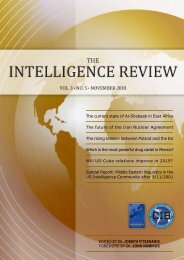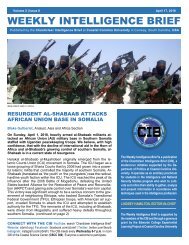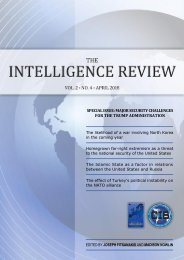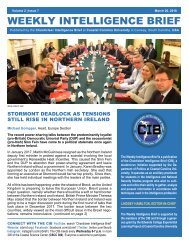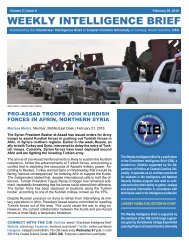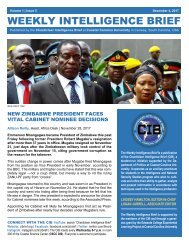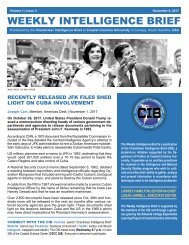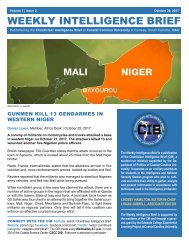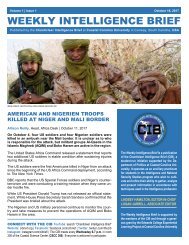The Intelligence Review | volume 3 | issue 6 |
This volume is the product of a collaboration between the European Intelligence Academy (EIA) and the Chanticleer Intelligence Brief (CIB), a pre-professional body supported by the Department of Politics at Coastal Carolina University in Conway, South Carolina, United States. Four CIB analysts tackle some of the most pressing and timely questions confronting intelligence observers today. Topics in this issue include the current and projected state of Sino-Russian relations, as well as recent and projected developments relating to the state of Russia’s Armed Forces. There is also an essay that focuses on the current and projected state of the Sinaloa cartel, one of Mexico’s most prolific organized criminal groups, whose leader, Joaquín Guzmán (also known as el Chapo), is currently serving a life sentence in an American Supermax prison. Last but not least, the present compendium includes an analysis of the leadership prospects of Israel’s embattled Prime Minister, Benjamin Netanyahu.
This volume is the product of a collaboration between the European Intelligence Academy (EIA) and the Chanticleer Intelligence Brief (CIB), a pre-professional body supported by the Department of Politics at Coastal Carolina University in Conway, South Carolina, United States. Four CIB analysts tackle some of the most pressing and timely questions confronting intelligence observers today. Topics in this issue include the current and projected state of Sino-Russian relations, as well as recent and projected developments relating to the state of Russia’s Armed Forces. There is also an essay that focuses on the current and projected state of the Sinaloa cartel, one of Mexico’s most prolific organized criminal groups, whose leader, Joaquín Guzmán (also known as el Chapo), is currently serving a life sentence in an American Supermax prison. Last but not least, the present compendium includes an analysis of the leadership prospects of Israel’s embattled Prime Minister, Benjamin Netanyahu.
You also want an ePaper? Increase the reach of your titles
YUMPU automatically turns print PDFs into web optimized ePapers that Google loves.
Background<br />
After decades of hostility during the Cold War, tensions between Moscow<br />
and Beijing began to thaw during the Gorbachev-Xiaoping era. In the<br />
second half of the 1980s, Soviet Premier Mikhail Gorbachev and<br />
Chinese Premier Deng Xiaoping chose to focus less on their<br />
countries’ respective ideological differences and instead look at the<br />
bilateral relationship with more pragmatism (Yeung and Bjelakovic<br />
2010:246). Due in part to the imminent collapse of the Soviet Union<br />
and the West’s pressure on China over Tiananmen Square, the two<br />
countries normalized relations between 1989 and 1991 (Yeung and<br />
Bjelakovic 2010:246).<br />
Throughout the 1990s and early 2000s, Russia and China gradually<br />
increased their bilateral cooperation in various fields; this would<br />
eventually lead to their landmark Treaty of Good Neighborliness and<br />
Friendly Cooperation in 2001 (Chase and Medeiros 2018:3). Four<br />
years later, the two countries surprised the international community<br />
by holding their first joint military exercise (Finn 2005). Since then,<br />
Russia and China have signed multiple bilateral agreements and have<br />
participated in several joint military exercises. <strong>The</strong>se developments<br />
demonstrate that the Sino-Russian relationship has undergone a<br />
gradual, positive rise that has evolved into a strategic partnership in<br />
the 21 st century (Yujun et al. 2018).<br />
Vostok 2018<br />
Sino-Russian military relations appeared to reach a new level of<br />
cooperation this past September. On September 11, 2018, Chinese<br />
troops participated alongside the Russian armed forces in the threeweek-long<br />
Vostok military exercise —thought to be Russia’s largest<br />
war games since the Soviet era (BBC 2018). According to Real Clear<br />
Defense, the exercise consisted of roughly “297,000 Russian service<br />
members, about 36,000 pieces of equipment, and more than 1,000<br />
aircraft, complemented by 3,200 Chinese soldiers and an unknown<br />
number of Mongolians” (Myers 2018). Although some speculate that<br />
the Russians may have exaggerated their troop numbers (Galeotti<br />
2018), even reduced figures would make this joint Sino-Russian<br />
exercise the largest to date (Zhou 2018).<br />
16







